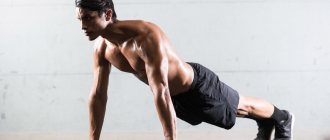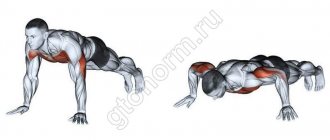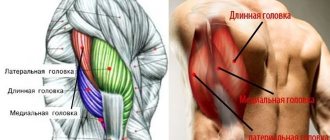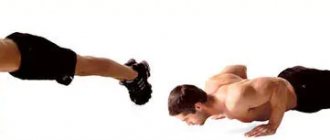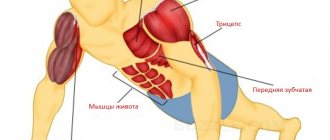Technique
Diamond grip push-ups are best performed after simple joint exercises. Rotate the brush in different directions for 1 minute. Repeat the same with your forearms. Complete the warm-up with smooth swinging movements of your arms back and forth. Start the exercise:
- Lower yourself into a plank position with your arms extended.
- Place your palms directly under your chest and bring them close. In this case, the thumbs and index fingers touch each other, forming the outline of a diamond (it turns out something like a triangle).
- Choose a comfortable position for your legs: spread apart or closed.
- Tighten your abdominal muscles, thighs and buttocks.
- Raise your head and look forward.
- Inhaling, gently lower your body until your sternum touches the backs of your hands.
- Exhale and, by tensing your triceps and chest muscles, rise to the starting position.
- Pause for a second at the top, then repeat the push-up.
Recommendations for implementation:
- Keep your shoulders close to your body. If you spread your elbows out to the sides, the payload will shift from the triceps to the pectoral muscles.
- Avoid arching in the abdominal region. Curving your back downwards will strain your lower back.
- Move evenly. Lowering and raising the body are carried out at the same pace.
Beginners do 3 sets of 12 repetitions. For trained athletes, we recommend progressive loads with each set.
When performed correctly and regularly, “diamond” push-ups can achieve the following results:
- increase in pushing force;
- strengthening the ligaments and joints of the hands;
- creating a beautiful shape of the upper limbs;
- development of small stabilizer muscles;
- abdominal tightening.
Benefits of diamond push-ups
It's hard to find a reason to include a new exercise in your training program. Especially if you don’t know what you need it for and how it can serve your purposes.
That's why I've compiled here all the benefits you'll get from using either the close-grip push-up or the extreme end of the diamond push-up. First of all, I will mention which muscles are pumped during diamond push-ups. If you know which muscles swing during a regular push-up, then there are several features.
Check them out below and decide for yourself how adding this exercise to your daily workout plan can make a big difference in your progress.
Triceps
It may be a little obvious, but these movements are undoubtedly one of the best triceps exercises.
Using your own body weight has its own challenges to target a specific muscle. And diamond push-ups are clear proof of this. Have you ever tried it? If yes, then you will understand what I mean!
Diamond push-ups activate the triceps much more than many other exercises. And they have the ability to increase the area of influence due to their complexity. Paired with push-ups, they will build your triceps much faster than any machine in the gym.
Shoulders
Regular push-ups are great for strengthening your shoulders. This is due to the fact that they carry most of your body weight to this area.
However, what most new to bodyweight exercises don't realize is that the complex angle at which diamond push-ups are performed puts even more stress on the shoulders.
When performed with proper form and diamond push-up technique, your shoulders will avoid injury. Your joints will be under new pressure. And this, in turn, will contribute to the growth of strength and muscle mass in this area.
It may be difficult at first (especially since it is such a new movement for your body to complete), but stick to it correctly and regularly to see improved results and growth in your shoulders!
Balance and core strength
If you do this exercise regularly, you will soon see that it can do wonders for developing your sense of balance. And it will also help you perform more complex exercises.
Changing your hand position (close-grip push-ups) requires your body to balance on a smaller surface area. And it used more energy for this. With regular practice, you will train your body. In order to get used to new movements, and this will become one of your physical skills.
You can use this skill to perform even more difficult exercises. Especially once you fully master this skill!
You will also gain strength and balance in your muscle core and body as a whole. After all, it works to keep your body balanced. The more you practice, the better results you will get. You can then increase your repetitions or difficulty of the exercise. This will help you take your results further (see the Diamond Push-Ups section for more information).
Also, this exercise can regulate the percentage of body fat so that your body has an attractive shape.
Varieties
Diamond push-ups, or in other words, “triangle” push-ups, are a complex exercise that requires preparation from the athlete. Therefore, we recommend that beginners perform the element with emphasis on their knees. And, conversely, more complex techniques are suitable for experienced athletes:
- On one leg. The lower extremities are supported on one foot, the other is supported in weight. This places additional stress on the triceps and on the muscles responsible for body balance.
- From the stand. The athlete takes the starting position, but places his feet on the platform so that the heels are above the line of the head. The technique also allows you to increase the load on the triceps.
We recommend that girls perform “diamond” push-ups from a vertical position. To do this, you need to stand about a meter from the wall, stretch out your arms and place your palms like a diamond on the surface. As you inhale, bend your elbows and bring your chest closer to your hands; as you exhale, straighten your limbs and return to the starting position.
Advantages and disadvantages
Let's look at what narrow-grip push-ups provide and what are their main advantages:
- The volume of the triceps increases;
- The triceps becomes stronger, more elastic, more resilient;
- The skin of the hands is tightened, especially the inner and lower surfaces (ladies will appreciate it);
- Strengthens the shoulder, elbow and elbow joints, as well as the core muscles;
Also, you can do push-ups with a narrow grip anywhere - at home, on the street, in the gym. The exercise does not require special equipment or a trainer to teach the technique.
Among the disadvantages, we note a weak load on the pectoral muscles, therefore, women who want to pump up their breasts are recommended to do push-ups with a wide stance. Also, this exercise will not help to significantly increase muscle size. But this disadvantage is inherent in any type of push-ups, since an increase in relief is impossible without power loads. In this case, work is carried out with your own weight.
Is it possible to harm the body with such a load? Yes, if you exercise while in a state that cannot be combined with sports exercises. Also, practice push-ups with caution if you have recently suffered an injury or sprain to the target ligaments, joints, or tendons. If you have diseases of the joints of the shoulder, elbow or wrist, push-ups are generally contraindicated.
Differences from other exercises
Quite often, diamond push-ups are confused with the close-grip push-up technique. The difference between these elements is significant:
- “Narrow” push-ups involve placing your palms at a distance of 25–30 cm or closer. This technique allows you to evenly distribute the load between the pectoral muscles and triceps.
- “Diamond” push-ups, due to the fact that the hands are turned towards each other and placed as close as possible, are intended exclusively for an accentuated effect on the triceps muscles of the arms.
Experienced trainers recommend not focusing on one version of push-ups, but performing them as a complex, using different muscle groups. For example, if an athlete wants to strengthen his arms and torso, he should combine classic push-ups, wide, narrow, as well as pushing out the body and clapping his hands in one training session. The presented elements are performed for 3–4 sets of 12–15 repetitions, 3 times a week
What muscles work
Narrow push-ups from the floor, bench or wall are designed to work the triceps brachii muscle. A complete atlas of the muscles involved is as follows:
- Target muscle: triceps;
- The pectoralis major and anterior delta bundles also work;
- The biceps, rectus abdominis, oblique abdominis, and quadriceps are involved in stabilizing the body.
Well, now you know what swings when doing push-ups with a narrow grip, then let's find out why you should do this exercise.
Expert advice
- Keep your body straight.
The most common mistake I see in gyms is allowing your hips to rise too high or drop too low. When you do a push-up, you must maintain a plank position so that your body creates one straight line that you lift and lower. - Move your shoulder blades: Ebenezer also noted that one of the most common mistakes when performing push-ups is trying to arch your back. This is absolutely not worth doing. If you do this, you will not be able to move your shoulders properly, which will make the push-up difficult. Rotator cuff problems can also develop because every time you do a push-up incorrectly, you force the shoulder joint to move in an unnatural way. Imagine having a nut between your shoulder blades that you need to squeeze as you lower yourself to the floor. Keep this picture in mind as you perform push-ups. As you lower yourself to the floor, tighten your back muscles, and then come back, unclenching your shoulder blades.
- Make sure you go low enough.
As you lower your body toward the floor, you must move through the entire range of motion and touch the floor, whether it be your nose, chest, or forehead. - If you cannot do the full amplitude, use a stand.
If you can't do full push-ups, find some kind of support, such as a chair, sofa or bench. Ab also believes that putting your knees on the floor when performing push-ups is not the best way to simplify the exercise, which is something people often try to do when mastering the movement, which is why they have difficulty transitioning from a knee push-up to a normal push-up. Much of the difficulty comes from not training the glutes and core enough and therefore lacking stability. Instead of starting your push-up journey from your knees, start on a bench - place your hands on the bench and perform push-ups. Slowly move from a high bench to a lower bench until you can perform push-ups. This will allow you to work with less load, but will not prevent you from training your core. At the gym, you can use a barbell to simulate push-ups.
Simplified types of push-ups for beginners
From my knees
If you are not yet trained enough to do them the standard way, try this simplified version. Place your weight on your knees, not your toes. Perform the push-up as you would normally, and when you can easily do a push-up on your knees, move on to the standard version.
At an angle
Perform push-ups on an incline. Push-ups become easier if you do them with your hands higher than your feet. Find any incline or place your hands on an exercise bench. Then you can do a simplified version of push-ups until you are trained enough to do regular push-ups.
Basic push-ups
Technique for performing push-ups
I.P.: Emphasis on outstretched arms, hands shoulder-width apart or slightly wider. The position of the hands during push-ups should be comfortable: the fingers are directed forward or at a slight angle - inward or outward, exactly how - depends on the individual characteristics of your wrists. A slight rotation of the brushes does not play a noticeable role. Legs are straight, slightly narrower than shoulder width apart. Look at the floor.
Make sure that your back does not arch and that your buttocks do not stick up. Legs, pelvis, back and shoulders should be in the same plane. This position is maintained throughout the entire exercise.
1. As you exhale, smoothly lower yourself to the floor, bending your elbows.
Lower yourself until your chest touches the floor (at least strive for this. If it’s difficult, at first you can not lower yourself all the way, but gradually increase the amplitude).
2. As you exhale, rise up, straightening your arms completely.
Breathing: inhale as you move down, and exhale as you lift your body up.
Execution speed. The effect obtained from the exercise depends on the speed of execution:
- Fast and explosive pushups (such as those with a chest pop) will help build strength and speed.
- Push-ups at a slow pace (for example, 15 counts down and 15 counts up) will help build significant endurance and muscle definition.
Common mistakes
- arched back;
- protruding buttocks;
- head raised up or down;
- lowering the pelvis before bending the arms or holding it at the top;
Muscles involved
- pectoral muscles;
- deltoid muscles;
- triceps;
- the muscles of the back, abs and legs also work.
Common mistakes
How to properly do push-ups from the floor with a narrow grip in order to avoid mistakes and achieve results faster?
- Control the position of your body, do not arch your back, do not stick out your buttocks;
- The elbows cannot be spread to the sides, because in this case the entire load goes to the back and pectoral muscles;
- At the top point, the arms are not fully straightened (to increase the load), and at the bottom they do not lie on the floor, supporting themselves by weight;
- Breathe correctly - lower as you inhale, rise as you exhale;
- Work smoothly - do not jerk or pause.
If you still don’t fully understand how to learn to do push-ups with a narrow grip, watch the video that we have attached for you. This way you will clearly see the correct technique and clarify unclear points.


